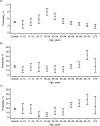Risk Factors for Community and Intrahousehold Transmission of SARS-CoV-2: Modeling in a Nationwide French Population-Based Cohort Study, the EpiCoV Study
- PMID: 37605838
- PMCID: PMC10773479
- DOI: 10.1093/aje/kwad174
Risk Factors for Community and Intrahousehold Transmission of SARS-CoV-2: Modeling in a Nationwide French Population-Based Cohort Study, the EpiCoV Study
Abstract
We assessed the risk of acquiring severe acute respiratory syndrome coronavirus 2 (SARS-CoV-2) from household and community exposure according to age, family ties, and socioeconomic and living conditions using serological data from a nationwide French population-based cohort study, the Epidémiologie et Conditions de Vie (EpiCoV) Study. A history of SARS-CoV-2 infection was defined by a positive anti-SARS-CoV-2 enzyme-linked immunosorbent assay immunoglobulin G result in November-December 2020. We applied stochastic chain binomial models fitted to the final distribution of household infections to data from 17,983 individuals aged ≥6 years from 8,165 households. Models estimated the competing risks of being infected from community and household exposure. The age group 18-24 years had the highest risk of extrahousehold infection (8.9%, 95% credible interval (CrI): 7.5, 10.4), whereas the oldest (≥75 years) and youngest (6-10 years) age groups had the lowest risk, at 2.6% (95% CrI: 1.8, 3.5) and 3.4% (95% CrI: 1.9, 5.2), respectively. Extrahousehold infection was also associated with socioeconomic conditions. Within households, the probability of person-to-person transmission increased with age, from 10.6% (95% CrI: 5.0, 17.9) among children aged 6-10 years to 43.1% (95% CrI: 32.6, 53.2) among adults aged 65-74 years. Transmission was higher between partners (29.9%, 95% CrI: 25.6, 34.3) and from mother to child (29.1%, 95% CrI: 21.4, 37.3) than between individuals related by other family ties. In 2020 in France, the main factors identified for extrahousehold SARS-CoV-2 infection were age and socioeconomic conditions. Intrahousehold infection mainly depended on age and family ties.
Keywords: COVID-19; SARS-CoV-2; coronavirus disease 2019; disease transmission; households; population-based surveys; seroprevalence; severe acute respiratory syndrome coronavirus 2.
© The Author(s) 2023. Published by Oxford University Press on behalf of the Johns Hopkins Bloomberg School of Public Health.
Figures





References
Publication types
MeSH terms
LinkOut - more resources
Full Text Sources
Medical
Miscellaneous

